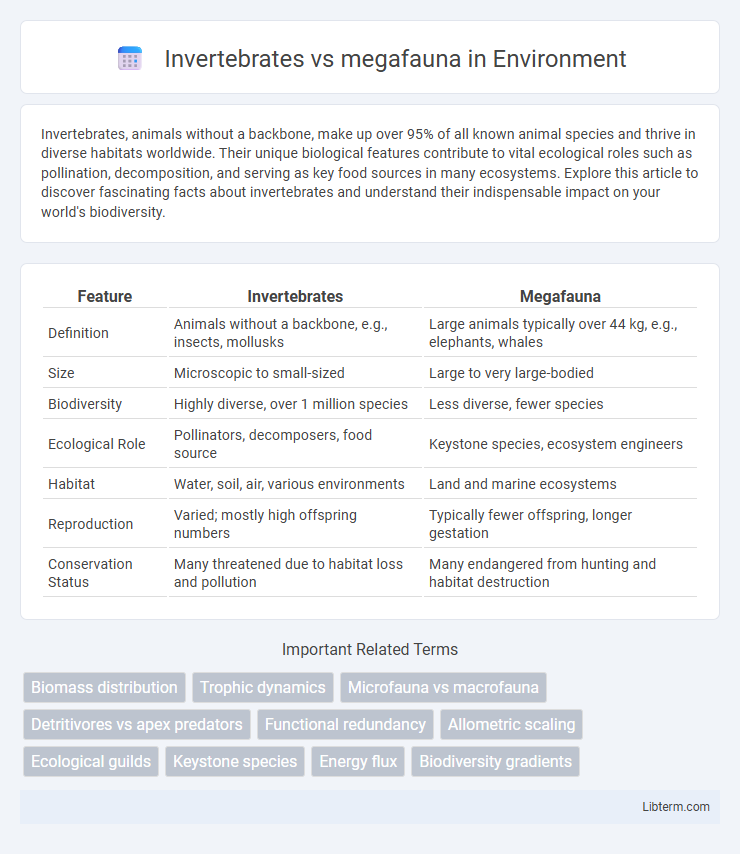Invertebrates, animals without a backbone, make up over 95% of all known animal species and thrive in diverse habitats worldwide. Their unique biological features contribute to vital ecological roles such as pollination, decomposition, and serving as key food sources in many ecosystems. Explore this article to discover fascinating facts about invertebrates and understand their indispensable impact on your world's biodiversity.
Table of Comparison
| Feature | Invertebrates | Megafauna |
|---|---|---|
| Definition | Animals without a backbone, e.g., insects, mollusks | Large animals typically over 44 kg, e.g., elephants, whales |
| Size | Microscopic to small-sized | Large to very large-bodied |
| Biodiversity | Highly diverse, over 1 million species | Less diverse, fewer species |
| Ecological Role | Pollinators, decomposers, food source | Keystone species, ecosystem engineers |
| Habitat | Water, soil, air, various environments | Land and marine ecosystems |
| Reproduction | Varied; mostly high offspring numbers | Typically fewer offspring, longer gestation |
| Conservation Status | Many threatened due to habitat loss and pollution | Many endangered from hunting and habitat destruction |
Understanding Invertebrates and Megafauna
Invertebrates, comprising over 95% of all animal species, are characterized by the absence of a vertebral column and include diverse groups such as insects, mollusks, and arachnids. Megafauna refers to large animal species, typically weighing over 44 kilograms, including iconic examples like elephants, whales, and giant ground sloths, which have played key roles in ecosystem dynamics and nutrient cycling. Understanding the contrasting biological features and ecological impacts of both invertebrates and megafauna is essential for biodiversity conservation and ecosystem management strategies.
Key Characteristics: Invertebrates vs Megafauna
Invertebrates are characterized by the absence of a vertebral column, typically possessing exoskeletons, segmented bodies, and a wide range of sizes from microscopic to several meters, such as giant squids. Megafauna refers to large animals, usually weighing over 44 kilograms, including both invertebrates like giant clams and vertebrates such as elephants and whales. While invertebrates exhibit diverse physiological adaptations to survive in various environments, megafauna are defined primarily by their large size, which influences their ecological roles and evolutionary pressures.
Evolutionary History and Adaptation
Invertebrates exhibit a vast evolutionary history dating back over 540 million years, characterized by remarkable adaptability to diverse environments through variations in body structure, reproductive strategies, and sensory mechanisms. Megafauna, emerging predominantly in the Cenozoic Era, evolved extensive size and specialized physical traits as adaptations to changing climates and ecological niches, promoting survival in predator-prey dynamics and resource competition. Both invertebrates and megafauna demonstrate distinct evolutionary pathways shaped by natural selection pressures driving diversification and ecological success.
Habitat Diversity and Geographic Distribution
Invertebrates exhibit remarkable habitat diversity, occupying environments from deep oceans and freshwater lakes to deserts and rainforests, with millions of species adapted to niche ecosystems worldwide. In contrast, megafauna, consisting of large-bodied animals such as elephants, whales, and giant reptiles, typically inhabit more specific geographic regions often shaped by climate and resource availability. The widespread distribution of invertebrates contrasts with the usually limited and fragmented ranges of megafauna, reflecting differences in ecological roles, mobility, and evolutionary pressures.
Ecological Roles and Importance
Invertebrates serve as essential decomposers, nutrient recyclers, and primary consumers in ecosystems, supporting soil health and plant growth. Megafauna influence habitat structure and biodiversity through their roles as top predators and ecosystem engineers, shaping vegetation patterns and nutrient distribution. Both groups maintain ecological balance by sustaining food webs and promoting species diversity.
Reproduction and Life Cycles
Invertebrates exhibit a wide range of reproductive strategies, including external fertilization and rapid life cycles with multiple larval stages that enhance survival and dispersal. Megafauna typically have slower reproductive rates, longer gestation periods, and extended parental care to increase offspring survival in complex ecological niches. These contrasting reproductive adaptations reflect evolutionary responses to environmental pressures and resource availability across different body sizes.
Threats and Conservation Status
Invertebrates face significant threats from habitat loss, pollution, and climate change, resulting in many species classified as vulnerable or endangered by the IUCN. Megafauna, such as elephants and whales, suffer from poaching, habitat fragmentation, and human-wildlife conflict, leading to critical conservation efforts and some species being listed as endangered or critically endangered. Conservation strategies for both groups emphasize habitat protection, anti-poaching measures, and international cooperation to mitigate declining populations.
Invertebrate Influence on Ecosystem Function
Invertebrates play a crucial role in ecosystem function by facilitating nutrient cycling, decomposing organic matter, and serving as a primary food source for megafauna and other wildlife. Their diverse activities enhance soil fertility and water quality, directly impacting habitat health and biodiversity. Unlike megafauna, whose influence often manifests at larger spatial scales, invertebrates drive fundamental ecological processes that support ecosystem resilience and stability.
Megafauna: Keystone Species Impact
Megafauna, as keystone species, play a critical role in maintaining ecosystem structure and function by regulating prey populations and facilitating nutrient cycling. Their influence extends across trophic levels, shaping habitat diversity and promoting biodiversity through activities like grazing, seed dispersal, and soil disturbance. The decline or removal of megafauna can lead to cascading ecological effects, highlighting their indispensable role in ecosystem stability and resilience.
Future Perspectives in Studying Invertebrates and Megafauna
Advancements in genomic sequencing and remote sensing technologies are revolutionizing the study of invertebrates and megafauna, enabling precise tracking of biodiversity and population dynamics. Integrating artificial intelligence with ecological modeling offers unprecedented opportunities to predict environmental impacts on these species, facilitating targeted conservation efforts. Expanding interdisciplinary research will enhance understanding of symbiotic relationships and ecosystem functions, promoting sustainable management strategies for both invertebrate and megafauna populations.
Invertebrates Infographic

 libterm.com
libterm.com